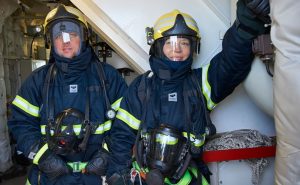The maritime industry operates in a challenging environment where safety is paramount. Onboard ships, safety officers and safety committees play a crucial role in ensuring compliance with international regulations, protecting crew welfare, and fostering a culture of safety. This article examines the responsibilities, training, and influence of safety officers and safety committees in minimizing risks and enhancing maritime operational security.
A safety officer is responsible for overseeing all safety-related activities on a ship. This role is mandatory under the International Safety Management (ISM) Code and the Maritime Labour Convention (MLC), ensuring ships operate in compliance with international maritime safety standards.

Key Responsibilities of a Safety Officer:
- Safety Inspections and Audits: Conduct regular inspections of safety equipment, fire systems, lifeboats, and personal protective equipment (PPE).
- Risk Assessment and Hazard Identification: Evaluate operational risks and implement control measures to mitigate potential hazards.
- Training and Drills: Organize safety training sessions, emergency drills, and onboard workshops.
- Incident Reporting and Investigation: Document accidents, near-misses, and safety breaches while ensuring corrective actions are taken.
- Regulatory Compliance: Ensure the ship meets the requirements set by the IMO, flag states, and classification societies.
For example, during a transatlantic voyage, a safety officer identified a fuel leak in the engine room’s auxiliary system. Immediate corrective action and adherence to reporting protocols prevented a potential fire, highlighting the critical role of proactive risk management.
–
Training and Certification Requirements

To qualify as a safety officer, individuals typically need:
- Relevant Seafarer Certification: Holding a senior rank such as Chief Officer or Second Engineer.
- Approved Safety Officer Training: Completion of specialized courses covering maritime safety regulations, risk management, and emergency preparedness.
- Familiarity with the ISM Code: A deep understanding of safety management system requirements.
Additionally, ongoing professional development ensures safety officers remain updated on the latest safety technologies, practices, and regulatory changes.
–
Establishing a Safety Committee Onboard
The establishment of a safety committee is an industry best practice that enhances safety oversight. The committee typically includes senior officers, department heads, and representatives from various shipboard teams. Functions of the Safety Committee:
- Policy Development: Establishing and reviewing ship-specific safety policies.
- Safety Meetings: Conducting regular meetings to address safety concerns and review incidents.
- Crew Engagement: Encouraging active participation from all crew members through safety discussions and feedback sessions.
- Performance Monitoring: Evaluating the ship’s safety performance through metrics like incident rates and compliance scores.
Enhancing Safety Culture Through Collaboration to Overcoming Challenges in Maritime Safety
A well-functioning safety committee fosters a culture where safety becomes an integral part of daily operations. In one notable example, a shipping company implemented a reward-based system recognizing crew members who identified and reported safety risks. This initiative led to a 35% reduction in onboard incidents over two years, illustrating how proactive engagement can yield significant safety improvements.
Despite such successes, several challenges continue to hinder the effectiveness of safety officers and committees. Crews from diverse cultural and linguistic backgrounds may interpret safety protocols differently, leading to potential miscommunication. Budget constraints can delay the acquisition of modern safety equipment, limiting the crew’s ability to respond effectively to emergencies. Additionally, long working hours can induce fatigue, reducing overall safety vigilance.
Addressing these challenges requires a multi-faceted approach. Continuous training ensures that safety protocols are universally understood and correctly applied. Investment in advanced technology enhances safety measures, while leadership commitment fosters a safety-driven work environment. By integrating these strategies, maritime organizations can build a resilient safety culture that prioritizes the well-being of their crews and vessels.
Case Study: A Safety Success Story
Consider a bulk carrier operating in international waters. Following a safety audit, the ship’s safety officer initiated a comprehensive safety awareness program involving monthly drills, improved signage, and updated PPE protocols. As a result, the ship passed its annual inspection with zero deficiencies, reinforcing the value of proactive safety management.
Technological Support for Maritime Safety
Modern technology enhances the capabilities of safety officers and committees through:
- Digital Safety Management Systems: Centralized platforms for incident reporting, audits, and compliance tracking.
- Wearable Safety Devices: Real-time monitoring of crew members’ vital signs during hazardous operations.
- Automated Emergency Alerts: Systems that trigger immediate alerts during emergencies like fire or gas leaks.
Safety officers and safety committees are indispensable in creating a secure maritime environment. Through vigilant risk management, regulatory compliance, and crew engagement, they ensure safer voyages and operational efficiency. Investing in continuous training, technological support, and fostering a proactive safety culture will further strengthen maritime safety in an evolving industry.


